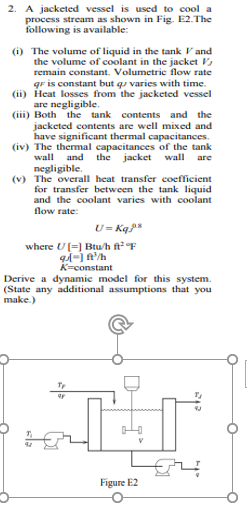2. A jacketed vessel is used to cool a process stream as shown in Fig. E2.The (i) The volume of liquid in the tank V and the volume of coolant in the jacket remain constant. Volumetric flow rate qF İs constant but q, vanes with time. (ii) Heat losses from the jacketed vessel (ii) Both the tank contents and the jacketed contents are well mixed and have significant thermal capacitances (iv) The thermal I capacitances of the tank wall and the jacket wall are negligible (V) The overall heat transfer coefficient for transfer between the tank liquid and the coolant varies with coolant flow rate where U[Btu/h fF K-constant Derive a dynamie model for this system. (State any additional assumptions that you make) Figure E2
2. A jacketed vessel is used to cool a process stream as shown in Fig. E2.The (i) The volume of liquid in the tank V and the volume of coolant in the jacket remain constant. Volumetric flow rate qF İs constant but q, vanes with time. (ii) Heat losses from the jacketed vessel (ii) Both the tank contents and the jacketed contents are well mixed and have significant thermal capacitances (iv) The thermal I capacitances of the tank wall and the jacket wall are negligible (V) The overall heat transfer coefficient for transfer between the tank liquid and the coolant varies with coolant flow rate where U[Btu/h fF K-constant Derive a dynamie model for this system. (State any additional assumptions that you make) Figure E2
Introduction to Chemical Engineering Thermodynamics
8th Edition
ISBN:9781259696527
Author:J.M. Smith Termodinamica en ingenieria quimica, Hendrick C Van Ness, Michael Abbott, Mark Swihart
Publisher:J.M. Smith Termodinamica en ingenieria quimica, Hendrick C Van Ness, Michael Abbott, Mark Swihart
Chapter1: Introduction
Section: Chapter Questions
Problem 1.1P
Related questions
Question
100%

Transcribed Image Text:2. A jacketed vessel is used to cool a
process stream as shown in Fig. E2.The
(i) The volume of liquid in the tank V and
the volume of coolant in the jacket
remain constant. Volumetric flow rate
qF İs constant but q, vanes with time.
(ii) Heat losses from the jacketed vessel
(ii) Both the tank contents and the
jacketed contents are well mixed and
have significant thermal capacitances
(iv) The thermal
I capacitances of the tank
wall and the jacket wall are
negligible
(V) The overall heat transfer coefficient
for transfer between the tank liquid
and the coolant varies with coolant
flow rate
where U[Btu/h fF
K-constant
Derive a dynamie model for this system.
(State any additional assumptions that you
make)
Figure E2
Expert Solution
This question has been solved!
Explore an expertly crafted, step-by-step solution for a thorough understanding of key concepts.
This is a popular solution!
Step 1
VIEWTrending now
This is a popular solution!
Step by step
Solved in 1 steps with 1 images

Recommended textbooks for you

Introduction to Chemical Engineering Thermodynami…
Chemical Engineering
ISBN:
9781259696527
Author:
J.M. Smith Termodinamica en ingenieria quimica, Hendrick C Van Ness, Michael Abbott, Mark Swihart
Publisher:
McGraw-Hill Education

Elementary Principles of Chemical Processes, Bind…
Chemical Engineering
ISBN:
9781118431221
Author:
Richard M. Felder, Ronald W. Rousseau, Lisa G. Bullard
Publisher:
WILEY

Elements of Chemical Reaction Engineering (5th Ed…
Chemical Engineering
ISBN:
9780133887518
Author:
H. Scott Fogler
Publisher:
Prentice Hall

Introduction to Chemical Engineering Thermodynami…
Chemical Engineering
ISBN:
9781259696527
Author:
J.M. Smith Termodinamica en ingenieria quimica, Hendrick C Van Ness, Michael Abbott, Mark Swihart
Publisher:
McGraw-Hill Education

Elementary Principles of Chemical Processes, Bind…
Chemical Engineering
ISBN:
9781118431221
Author:
Richard M. Felder, Ronald W. Rousseau, Lisa G. Bullard
Publisher:
WILEY

Elements of Chemical Reaction Engineering (5th Ed…
Chemical Engineering
ISBN:
9780133887518
Author:
H. Scott Fogler
Publisher:
Prentice Hall


Industrial Plastics: Theory and Applications
Chemical Engineering
ISBN:
9781285061238
Author:
Lokensgard, Erik
Publisher:
Delmar Cengage Learning

Unit Operations of Chemical Engineering
Chemical Engineering
ISBN:
9780072848236
Author:
Warren McCabe, Julian C. Smith, Peter Harriott
Publisher:
McGraw-Hill Companies, The